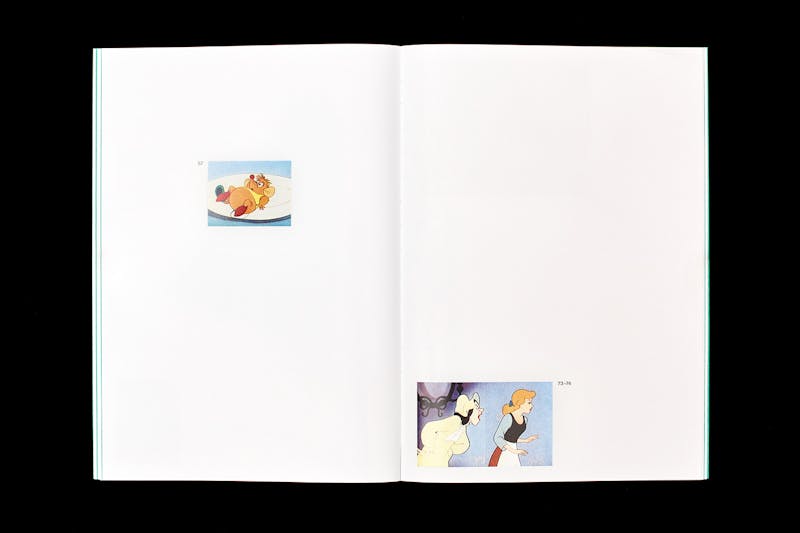“The bastard form of mass culture is humiliated repetition: content, ideological schema, the blurring of contradictions — these are repeated, but the superficial forms are varied: always new books, new programs, new films, news items, but always the same meaning.”1
The book you’re holding is a replica of a Panini sticker album from 1980, the kind of thing which, for many millennials like me, was a staple on our kitchen tables growing up – spending our measly pocket money on countless packets of stickers, desperate to fill the missing squares and passing hours poring over the facts and statistics about footballers, before tossing the whole thing aside once the chase became too great.
As a conceptual artist, Lenard Giller wasn’t drawn to this all-but forgotten relic out of a sense of nostalgia; rather, his intrigue was piqued by buying a stack of second-hand Panini stickers dedicated to Disney’s 1950 animated film, Cinderella. This version of the fairy-tale was refracted across all sorts of printed forms, for advertisements in newspapers, spin-off books and comics, and, in an iteration that struck a chord with Giller, these collectable stickers treasured by children. In particular, the way the stickers presented the prominent moments of the story, chosen from thousands of other possible scenes, fascinated him. To Giller, this constant circulation through various media is similar to the journeys cultural icons make these days via the internet, as they are downloaded, reshaped, formatted, and shared to suit our ever more impatient needs.
Giller analysed his set of stickers, and soon realised he’d found frames only from the exact middle to the end of Cinderella. He began considering how he might complete the set. He traipsed through countless advertisements from people who’d surrendered their part-completed collections. Later, he’d come to realise that the full set was made up of 360 images – a complete circular loop, just like the spool of a film reel. This pertinent discovery informed a plethora of ideas for artworks. Reflecting the innumerable iterations the film has been squeezed into, Productions, too, comes in various forms: the book you’re holding now, a 16mm film and 17 prints. The premise of Cinderella reflected the zeitgeist of 1950s America – girl meets prince, they marry and live happily ever after. Giller notes his fascination for ‘how just few hundred images from thousands of frames could easily represent and narrate a story that had been part of a collective memory since the making of the film thirty years earlier, so much so that most viewers are able to imagine the parts of the Disney cartoon that are missing.’ Which itself, was not in any real sense the original: the first known version of the Cinderella story was written by Greek geographer Strabo between 7BC and 23AD, and it has been appropriated many times since, most recently as a 2021 film by Amazon Studios. Gillard’s stickers were also subject to the circulation and changing of different hands over the past forty years, more than ten of which were made before the internet’s inception. Reassembling the story, he rendered the 360 stickers onto 16mm celluloid film, placing them along a timeline which corresponds to the entire length of the film. Each image is then transferred inside the exact time-frame during which it first appeared in Disney’s 1950 Cinderella. This cinematic version of Productions rolls on for 81 minutes with incremental flashes of alternating blank film at Galerie Noah Klink. This is reminiscent of the effect of lifting the pages now at your fingertips: each turn unfurls more of the tale, dispersed in a grid of blank squares that mirrors the original Panini book design.

Lenard Giller, Productions, 2022. Published by Veii
The study of animations to interrogate the cultural mores of different times has long been explored by artists. In Mathias Poledna’s 2013 animation, Imitation of Life, he uses techniques from the 1920s golden era of animation, as a buoyant donkey sings longingly to a depleted forest of animals, symbolising hope following the First World War. Similarly, and while on the subject of donkeys, in Larry Johnson’s Untitled (Ass), the animal is depicted in a style reminiscent of a Disney cartoon, with his backside being poked by a pencil eraser held by the artist – Johnson frequently uses animations that wittily fetishize queer subcultures in Los Angeles. Both examples utilise the playful nature and universal appeal of animation to make claims about the politics of the past.
Barthes’ epigraph on mass culture, quoted at the outset, lucidly reflects how Giller approaches various forms of post-production, noticing that whichever mode Cinderella had been manoeuvred through, whether film or in print, meaning had substantially stayed the same. Having also watched every contemporary restoration of Cinderella, he realised they’d ‘received a facelift’, but rarely diverted from the original tale. Giller’s version subverts this: although the order in which he places his Panini stickers in the 16mm version follow a familiar chronology, events are left out as a result of the Panini albums structure. Productions is stripped of the customary three-act structure of films; none of the characters are suitably introduced, confrontations take place without explanation and the resolution is left unresolved. What remains is a broken up storyboard, a slimmed down tale told through drawings, the characters becoming innocuous with their voices from the original film and their emotional journeys entirely absent. It becomes as much about the processes of production as it is about the story, Giller exposing the limits of how entertainment is made, when all is reduced to its core. As the sound of the projector cogs turn, or the pages rustle, we’re reminded again of the components that make our media accessible and our own stories complete.
Roland Barthes, The Pleasure of the Text, Éditions du Seuil, 1973